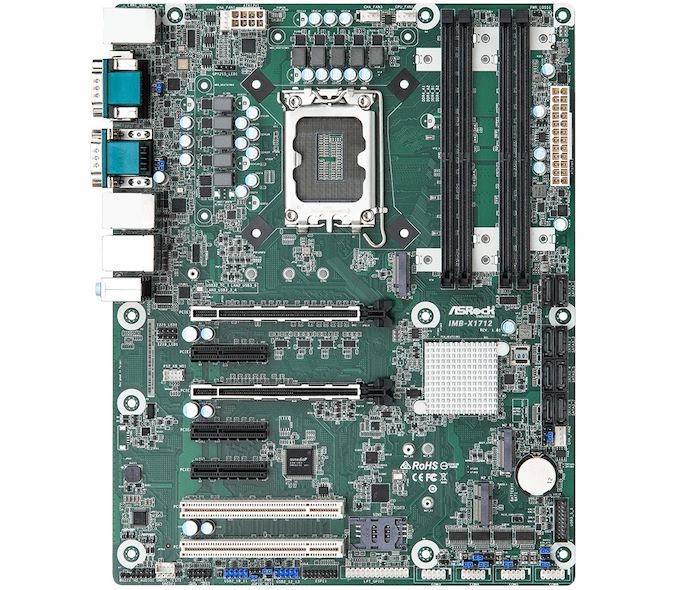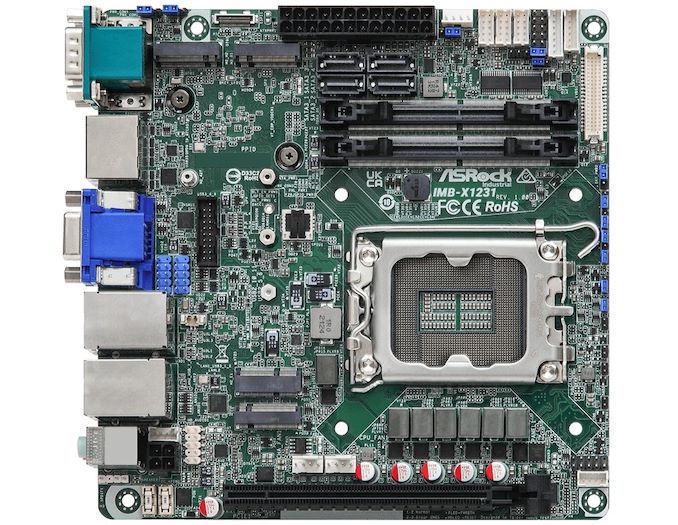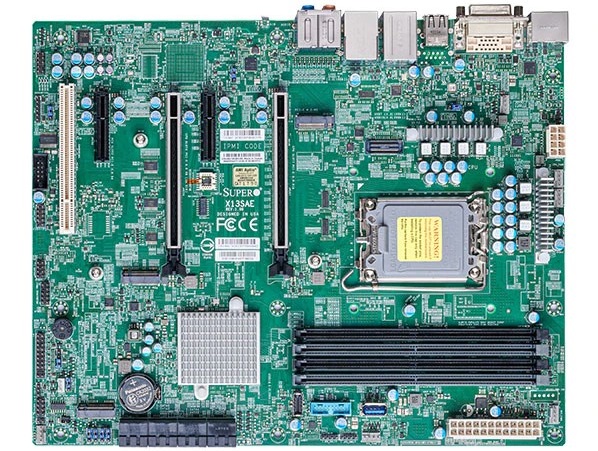Earlier this month Intel quietly launched its W680 chipset, the corporate’s workstation-focused chipset for its twelfth Gen Core (Alder Lake) processors. In contrast to the present technology of shopper desktop chipsets akin to Z690, H670, B660, and H610, the W680 provides the aptitude to make use of ECC DRAM, together with each DDR5 and DDR4 variants. At current, there have not been many W680 motherboard bulletins, though a few distributors, together with ASRock Industrial and Supermicro have a couple of choices listed. So we’re providing you with the lowdown on W680, what it has to supply, and what applied sciences it brings for customers seeking to construct a workstation-class desktop with Intel’s newest Alder Lake structure.
The Intel W680 Chipset: Enabling Alder Lake Workstations
Sometimes when Intel launches a brand new sequence of processors for the desktop market, it releases a number of chipsets with various ranges of options. For its twelfth Gen Core household, Intel initially launched its CPUs and premium Z690 chipset, and adopted that up with its extra inexpensive H660, B660, and H610 chipsets. In most generations the product stack is rounded out a bit later with a W-series workstation-focused chipset, and at last a wide range of Xeon-E sequence.
Enter the Intel W680 chipset, which is Intel’s designated workstation chipset for its twelfth Gen Core platform. The Intel W680 chipset is attention-grabbing for a wide range of causes, not the least of which is that that it formally opens up ECC reminiscence help for Intel’s Alder Lake-S desktop processors.

Intel W680 Chipset Block Diagram
Among the predominant options of the W680 chipset embrace a PCIe 4.0 x8 DMI hyperlink, which connects the processor to the chipset for improved bandwidth over Intel’s earlier W-series chipsets. Different options embrace help for as much as eight SATA ports and built-in Wi-Fi 6E PHY/2.5 GbE MACs for distributors to hook within the newest networking controllers. Intel contains help for 16x PCIe 5.0 lanes from the CPU, with the standard 16/0 or 8/8 bifurcation choices.
| Intel W680, Z690, W580, and W480 Chipset Comparability | ||||
| Characteristic | W680 | Z690 | W580 | W480 |
| Socket | LGA1700 | LGA1700 | LGA1200 | LGA1200 |
| uArch | Alder Lake | Alder Lake | Rocket Lake | Comet Lake |
| PCIe Lanes (CPU) | 16 x 5.0 4 x 4.0 | 16 x 5.0 4 x 4.0 | 20 x 4.0 | 16 x 3.0 |
| PCIe Lanes (Chipset) | 12 x 4.0 16 x 3.0 | 12 x 4.0 16 x 3.0 | 24 x 3.0 | 24 x 3.0 |
| PCIe Specification (CPU) | 5.0/4.0 | 5.0/4.0 | 3.0 | 3.0 |
| Reminiscence Help | DDR5-4800B DDR4-3200 | DDR5-4800B DDR4-3200 | DDR4-2933 | DDR4-2933 |
| ECC Reminiscence | Y | N | Y | Y |
| DMI Lanes | x8 4.0 | x8 4.0 | N/A | N/A |
| Max USB 3.2 (Gen2/Gen1) | 10/10 | 10/10 | 6/10 | 6/10 |
| USB 3.2 Gen 2×2 (20 Gbps) | Y | Y | ASMedia | ASMedia |
| Complete USB | 14 | 14 | 14 | 14 |
| Max SATA Ports | 8 | 8 | 8 | 8 |
| Reminiscence Channels (Twin) | 2/2 | 2/2 | 2/2 | 2/2 |
| Intel Optane Reminiscence Help | Y | Y | Y | Y |
| Intel Fast Storage Tech (RST) | Y | Y | Y | Y |
| Built-in Wi-Fi MAC | Wi-Fi 6E | Wi-Fi 6E | Wi-Fi 6 | Wi-Fi 6 |
| Intel Good Sound | Y | Y | Y | Y |
| Overclocking Help | Y | Y | N | N |
| Intel vPro | Y | N | Y | Y |
| ME Firmware | 16 | 16 | 15 | 14 |
| TDP (W) | 6 | 6 | 6 | 6 |
Different options with W680 embrace native help for USB 3.2 Gen2x2 (20 Gbps) Kind-C connectivity. Nonetheless, a lot of the value and implementation of networking and connectivity nonetheless rely on distributors utilizing options by way of proprietary CNVi connections. That is a lot the identical story on common Z690, H670, B660, and H610 choices, the price for the goal market is an enormous issue right here on what distributors resolve to incorporate or omit. The purpose is the aptitude is there ought to a vendor want to put it to use.
Intel W680: Now with Official Overclocking Help for CPU & Reminiscence
On the entire, there is not a lot distinction between the W680 and Z690 chipsets when evaluating technical specs. This contains bundle dimension (each are 28 x 25 mm), USB, PCIe, and storage help, however apparently there is a new addition to Intel’s newest desktop workstation chipset. This ‘new’ inclusion is official help for overclocking, which is one thing each of the earlier W-series chipsets – W580 and W480 – omitted.
Whereas the final couple of W-series chipsets allowed customers to overclock the reminiscence on supported processors, Intel has opened this as much as unlocking the core frequency when mixed with its Ok-series processors on W680. And whereas this performance is appreciated, it is admittedly unlikely customers will wish to considerably overclock an already sizzling working and high-powered Alder Lake processor, particularly on a motherboard that does not have a strong energy supply system like Z690 motherboards do.
The purpose to that is Intel is giving customers a selection, and whereas it sounds nonsensical in apply, it is a fairly large transfer for conservative Intel. It ought to be famous that its H610 chipset does not help CPU overclocking; it is an attention-grabbing shift from Intel’s earlier standpoint in the case of overclocking.
W680 Motherboards: What’s Presently Introduced (As of March ninth)
Regardless of Intel choosing a sluggish ramp up for its W680 chipset, a couple of motherboard choices are formally listed, together with from ASRock Industrial and Supermicro. As time goes by, and maybe when Intel pulls the set off on its compulsory Xeon E-3300 household of processors, motherboard distributors would possibly choose to formally announce extra fashions.
The important thing component with W680 is that whereas they provide help for current Alder Lake-S processors, they’re designed round its Xeon sequence, which are not often overclockable. These fashions usually function decrease core frequencies and TDPs, given their higher deal with reliability versus efficiency.
ASRock Industrial W680
Because it stands, ASRock Industrial has 4 W680 motherboards listed on the time of writing. This contains one thin-ITX mannequin (IMB-X1233-WV), one mini-ITX mannequin (IMB-X1231), one micro-ATX mannequin (IMB-X1314) and one full-sized ATX mannequin (IMB-X1712).

The ASRock Industrial IMB-X1712 ATX (W680) motherboard.
All of ASRock Industrial’s W680 choices embrace help for ECC DDR4-3200 reminiscence and supply various ranges of PCIe 4.0 and storage help. The PCIe 4.0 help depends upon the shape issue because the ITX sized choices are restricted to only one full-length PCIe 4.0 slot, whereas the IMB-X1314 and IMB-X1712 have two full-length PCIe 4.0 slots obtainable. For the ITX sized fashions, each profit from twin 2.5 GbE, whereas the bigger fashions have three 2.5 GbE controllers, all of which use Intel I225-LM controllers to energy every Ethernet port throughout all fashions. It is value noting that the IMB-X1712 contains two PCI slots for legacy gadgets.

The ASRock Industrial IMB-X1231 mini-ITX (W680) motherboard.
Each the IMB-X1233-WV and IMB-X1231 ITX sized choices permit help for Alder Lake-S processors with a most TDP of 65 W, whereas the micro-ATX IMB-X1314 and ATX IMB-X1712 allow customers to make use of processors with a base TDP of as much as 125 W. Help and compatibility listed below are aligned and decided by the bottom frequency TDP score on these fashions.
On the time of writing, ASRock Industrial hasn’t introduced any availability or pricing for any of its W680 fashions.
Supermicro W680
For Intel’s W680 chipset launch, Supermicro has listed two motherboards designed across the new chipset. This contains the X13SAE and the X13SAE-F motherboards. These fashions are ATX in dimension and embrace help for DDR5-4400 reminiscence, each ECC and non-ECC DRAM varieties.

The Supermicro X13SAE ATX (W680) motherboard.
Regardless of each the Supermicro X13SAE and X13SAE-F that includes the identical base specs, together with twin Ethernet, one powered by an Intel I225-V 2.5 GbE and the opposite by an Intel I1219-LM Gigabit controller pairing, there’s one key distinction. The Supermicro X13SAE-F contains IPMI performance which is powered by an ASPeed AST2600 BMC controller and features a supplementary Realtek RTL8211F administration LAN port.
Each of the Supermicro X13 (W680) permit customers to make use of Alder Lake-S processors with a base TDP of 125 W, and each are utilizing a Realtek ALC888S HD audio codec. They share the identical connectivity choices, together with HDMI 2.1, DisplayPort 1.4, and DVI video outputs, in addition to three USB 3.2 G2 Kind-A and one USB 3.2 G1 Kind-A port on the rear panel.
On the time of writing, Supermicro hasn’t shared any data relating to the supply or pricing on its X13 (W680) motherboards.
For different LGA1700 choices akin to Z690 motherboards, beneath now we have an inventory of our detailed Intel Alder Lake protection:


0 Comments